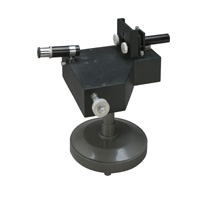In Fabry - Perot interferon,
the distance between the partially reflecting mirrors are varied by using
coarse and finely adjustable translation stage driven by micro-meters. One
beam splutter is fixed and the other is mounted on the translation
stage through a kinematic mount. This two axis kinematic mount is used to
correct the parallelism between beam splutters.
The Fabry - Perot design
contains plane surfaces that are partially reflecting so that multiple rays of
light are responsible for the creation of the observed interference patterns.
For high resolution spectroscopy, where a resolution in the range of MHz to GHz
is required, a Fabry - Perot interferon (FP) is used. The FP consists
of two plane mirrors mounted accurately parallel to each another, with an
optical spacing off’s between them.
The enclosed air gap
generally varies from several millimeters to centimetres, when the device
is used interferometrically. If the gap can be mechanically varied by moving
one of the beam splutters, then the device is referred to as
an interferon. Its transmission spectrum as a function of wavelength
exhibits peaks of transmission corresponding to resonances of the etalon. Fabry
- Perot interferometers are widely used in telecommunication, lasers and
spectroscopy for controlling and measuring the wavelength of light.


